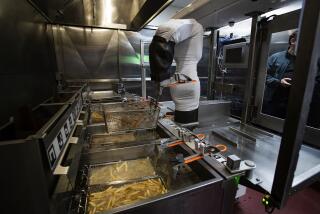COLUMN ONE : Tracking Life in the Fast Lane : So many people are feeling pressed for time that companies are quick to crank out time-saving products and services. But there’s a downside.
Just a second, please.
Are you too busy to thumb through a 300-page novel? Too harried to hack the wait at even a fast-food restaurant?
Then this story is for you. It’s about how American marketers, having discovered that millions of people feel pressed for time, are coming up with ever-speedier services and spiffier time-saving products for consumers.
It’s also about the toll the nation’s near-obsession with these conveniences is taking on some workers and the quality of life in general.
That, in a nutshell, is the story. But if you’ve already saved enough time by grocery shopping at a drive-through supermarket, washing your hair with a combination shampoo-conditioner and making popcorn in the microwave, then how about sticking around to savor this full-length feature?
After all, saving time for what you really want to do is what time-saving conveniences are supposed to be all about.
In the era of the fax machine, the microwave oven and the harried American consumer, what people once considered fast isn’t fast enough anymore. Marketers are responding by cranking out innovations, and sometimes simple gimmicks, to appeal to people who seemingly will try almost any shortcut to keep pace with their crammed daily schedules.
Grocers are testing shopping carts with video screens that help guide customers more quickly to daily specials. Entrepreneurs are making house calls so that consumers can get their hair cut or their car fixed without wasting minutes on the road or in the shop. Publishers are bringing out more collections of short stories, apparently in hopes of attracting time-conscious readers.
So widespread is the trend that it can touch nearly every minute of a consumer’s waking day--from making coffee with a pre-measured packet of Maxwell House in the morning to reading a one-minute bedtime story to the children at night.
“Are we getting so pressed for time that we want to condense everything? For some people, it seems that way,” said Roger Selbert, a futurist and business consultant.
What lies behind the allure of time-saving conveniences is, to some extent, a matter of debate. The standard wisdom is that the surge in two-income families and a rise in careerism in the 1980s translated into more stress and less free time for American families.
But in what probably is the most intensive research on the topic, University of Maryland sociology professor John P. Robinson found in a series of surveys that the average American actually gained about five hours of leisure a week between 1965 and 1985. By 1985, his studies show, the average amount of leisure climbed to nearly 40 hours a week as a result of declines in the amount of time spent on the job, on housework and, because of low birthrates, on child care.
Robinson, director of the Americans’ Use of Time Project, hasn’t conducted a similar study since 1985, but he says that employment statistics and television ratings suggest that free time has held steady over the last five years.
Still, Robinson and other experts agree that regardless of what really is the case, Americans generally feel as though they have less free time. The possible reasons include intensified job pressures, the dizzying explosion in leisure options--even for couch potatoes, there is more on television to choose from--and the fact that many members of the vocal baby boom generation only recently got around to having children of their own.
Meanwhile, the list of what some people consider essential activities got longer. (Hallmark Cards is making calendars with bigger day boxes because consumers complained they didn’t have enough room to fill in all of their daily plans.)
Ten years ago, for example, exercise “was a discretionary use of time,” said Leonard L. Berry, director of the Center for Retailing Studies at Texas A&M; University. “Now, it’s something we have to do. We have to take care of our bodies, we have to stay fit. Our concept of what is leisure and what isn’t is changing, it’s a moving target.”
The payoff for some firms that have found ways to relieve consumers’ anxieties about time has been dazzling.
Citicorp, powered by its 15-day mortgage approval program, has become the nation’s biggest home lender. Domino’s Pizza, which has ridden to success with its 30-minute delivery guarantee, is the second-fastest-growing franchise operation in the United States. Pert Plus, a combination shampoo-hair conditioner made by Procter & Gamble, emerged late last year as the top-selling U.S. shampoo.
Food marketers--including grocers, processors and restaurants--long have been pioneers in providing speedy service and time-saving products, and they continue to lead the way.
Arby’s, the roast beef sandwich chain, is installing computer systems that let customers place orders by pressing the listings on a heat-sensitive “touch screen,” instead of going through the bother of telling someone what they want. The company said it expects to shave 30 seconds or more from the one to two minutes it normally takes from when an order is placed to when it is received.
Another fast-food innovator, Burger King, last month announced plans to test color video screens at drive-through windows so that customers and order takers can see each other, a change that is supposed to help people communicate better and avoid time-wasting mistakes.
Microwave cooking, meanwhile, has become part of the fabric of American life. An estimated 80% of U.S. homes now have microwave ovens. Although many fast meals prepared specifically for microwave cooking have been duds--both as culinary creations and commercial products--microwave popcorn has been a hit for years and sales of frozen hamburgers and waffles are skyrocketing.
Even some microwaveable products aren’t fast enough for consumers, however. Ron Paul, president of the food industry consulting firm Technomic Inc., said his company’s research has shown dissatisfaction with two-step microwave meals--meals that, for instance, might require the food to be heated for two minutes with a cover on and then three minutes with the cover off.
“It may be a four-minute or five-minute item, but that’s still too long,” Paul said. “That’s how spoiled we’ve become.”
To speed shopping, supermarkets and other types of stores are redesigning their layouts. Vons supermarkets is experimenting with a drive-through lane and a “convenience store within a store” designed especially for customers looking for a limited number of items in a hurry.
Other grocers, taking a cue from the gas station business, are investigating self-service checkout lanes, where customers would whisk their packages across laser scanners to ring up their purchases.
One of the most profound changes in retailing resulting from the demand for convenience is the rise in catalogue shopping, particularly with the use of toll-free telephone numbers. In the last three years, catalogue sales have climbed nearly 15% annually, more than double the gains of traditional retailers selling comparable merchandise.
Other industries also are offering a trove of services and products for people who are short of time. Marriott Corp. is testing a system that lets guests save time by checking in while they are riding on the airport shuttle to their hotel.
Prodded by the likes of Harry Hoffman, president of the giant Waldenbooks chain, publishers appear to be warming to the idea of coming out with shorter books. Already, publishing experts say, there has been a noticeable increase in books of short stories.
“People who have very busy lives feel they can handle short story collections that won’t keep them committed for a long period of time,” said Sybil Steinberg, fiction editor of Publishers Weekly.
Newspapers are overhauling their formats to provide news summaries and help readers find what they want more quickly. Two leading examples over the last few years have been The Times, which is now advertised as “the new faster-format Times,” and the Wall Street Journal, which is billed as “Faster. Tougher. Smarter.” In addition, short stories and easy-to-understand charts have been trademarks of USA Today since the paper was launched in 1982.
Plenty of time-saving innovations, however, have failed to pass muster. As a general rule, consumers will pay a premium for speed, but only so much. For example, catalogue retailers L. L. Bean and Lands’ End offer Federal Express delivery for customers who want their orders in as little as two days, eliminating several days of waiting, but both firms say few customers request it.
Computerized home banking, pitched by the banking industry as a time saver, has proved to be a tough sell to customers, many of whom are turned off by PC technology.
Workers are ambivalent about speedy service, too. At some companies, morale improves when employees do a better job of dealing with customers.
But when companies want to speed up service, “all too often they turn up the heat” on employees rather than develop more efficient work systems, said George Stalk Jr., co-author of a recent business book titled “Competing Against Time.”
In the supermarket industry, the adoption of time-saving laser scanners and computerized cash registers on the checkout line appears to have contributed to an epidemic of worker injuries, known collectively as cumulative trauma disorders. These painful disorders, which include tendinitis and carpal tunnel syndrome, are linked to repetitive actions such as the wrist motion a checker must make to pass products over a scanner.
A recently completed study of 175 supermarket workers by the National Institute for Occupational Safety and Health found that 52% of the checkers have developed hand, neck, shoulder or elbow injuries since starting their jobs. Among the other supermarket workers, 31% had such injuries.
Deborah Berkowitz, director of safety and health for the United Food and Commercial Workers Union in Washington, claimed that a big part of the problem is that employers use their automated checkout systems to monitor checkers. The result, she maintained, is that checkers are pushed to work faster, causing more frequent and more serious injuries.
In perhaps the biggest controversy linked to fast service, the Domino’s Pizza chain is accused by critics of encouraging employees to drive recklessly to make sure its pizzas are delivered within the guaranteed 30 minutes. The critics note that roughly 20 people were killed in accidents involving on-duty Domino’s drivers in 1988, the last year for which statistics were made public.
“It’s an unrealistic policy,” said Joseph A. Kinney, executive director of the National Safe Workplace Institute. “It doesn’t take into account weather conditions or congestion. . . . There are about 40 things it fails to consider.”
Domino’s denies any negligence or wrongdoing, citing various safety measures it has adopted. “If you have that many drivers on the road, you are going to have some traffic incidents,” a Domino’s spokeswoman said.
For society at large, some observers say, the nation’s thirst for time-saving conveniences has grown to the point where it can undermine the quality of our lives in both down-to-earth and subtle ways.
The quality of microwave cooking and fast-food restaurant meals is a frequent target of the critics. “The food can taste terrible, and usually it does, but it’s gratifying to get it in a hurry,” said Mark Crispin Miller, head of the media studies department at Johns Hopkins University.
On another level, psychologists and social critics maintain that many people are overwhelmed and anxiety-ridden because of the fast pace of modern life--a pace that is fostered by time-saving products and services. In fact, in what may be a partial rebellion against high-speed living, the 1990s are expected to be a period of “cocooning,” with many people spending more time at home.
“For every benefit technology brings, it takes something away,” said Carol Tavris, a Los Angeles social psychologist. New time-saving gadgets, she said, “can be wonderful. They can also be exasperating, difficult and stressful.”
Mihaly Csikszentmihalyi, a University of Chicago social psychologist and author of the recent book “Flow,” said the pursuit of time-saving conveniences has taken on a life of its own and for many people has become self-defeating. He contends that people too often rush through their daily activities to create more free time for themselves, but then spend that extra time narcotized in front of their television sets or doing something else that is unchallenging and unrewarding.
“Everybody wants more free time. The fact is, though, when they get it, they don’t enjoy it,” Csikszentmihalyi said.
All the same, corporate marketers still believe that consumers crave time-saving conveniences. “We keep hearing people say, ‘Anything you can do to make my life easier, I’m all for it,’ ” said Michael DeMent, a spokesman for Hallmark Cards.
Added Paul, the food industry consultant: “We live in a fast society and we want everything now. We don’t want to wait for it. And when we’re in a hurry, it can never be too fast.”
OUTPACING THE STORES
Percent Percent Mail order gain over Gen’l merchandise gain over Year sales (billions) prior year sales* (billions) prior year 1986 $49 9% $169 6.7% 1987 56 14 182 7.5 1988 64 14 192 5.4 1989 74 15 203 5.6
*Includes sales at department stores, discount stores, variety stores and other general merchandisers. Figures include some mail order sales by stores that have both conventional retailing and catalogue operations.
Sources: U.S. Commerce Department, Marke/Sroge Communications
MICROWAVE FOOD SALES These are annual U.S. sales figures for two groups of food products. One group consists of foods such as microwave popcorn and frozen waffles that are specially prepared to be cooked in a microwave oven. The other group consists of competing frozen, refrigerated and dry packaged foods that are not designed principally as microwave products. All figures are in millions.
Microwave Microwave Competing share of Year foods products market 1987 $1,153.6 $18,613.7 5.6% 1988 1,908.7 23,384.0 7.5 1989 2,147.1 24,812.4 8.0
Source: Arbitron/SAMI
More to Read
Sign up for our Book Club newsletter
Get the latest news, events and more from the Los Angeles Times Book Club, and help us get L.A. reading and talking.
You may occasionally receive promotional content from the Los Angeles Times.






